State of the Market Briefs
Housing Affordability and SMMF Preservation Challenges
Housing Affordability and Small to Medium Multifamily Preservation Challenges in the Atlanta, GA Region
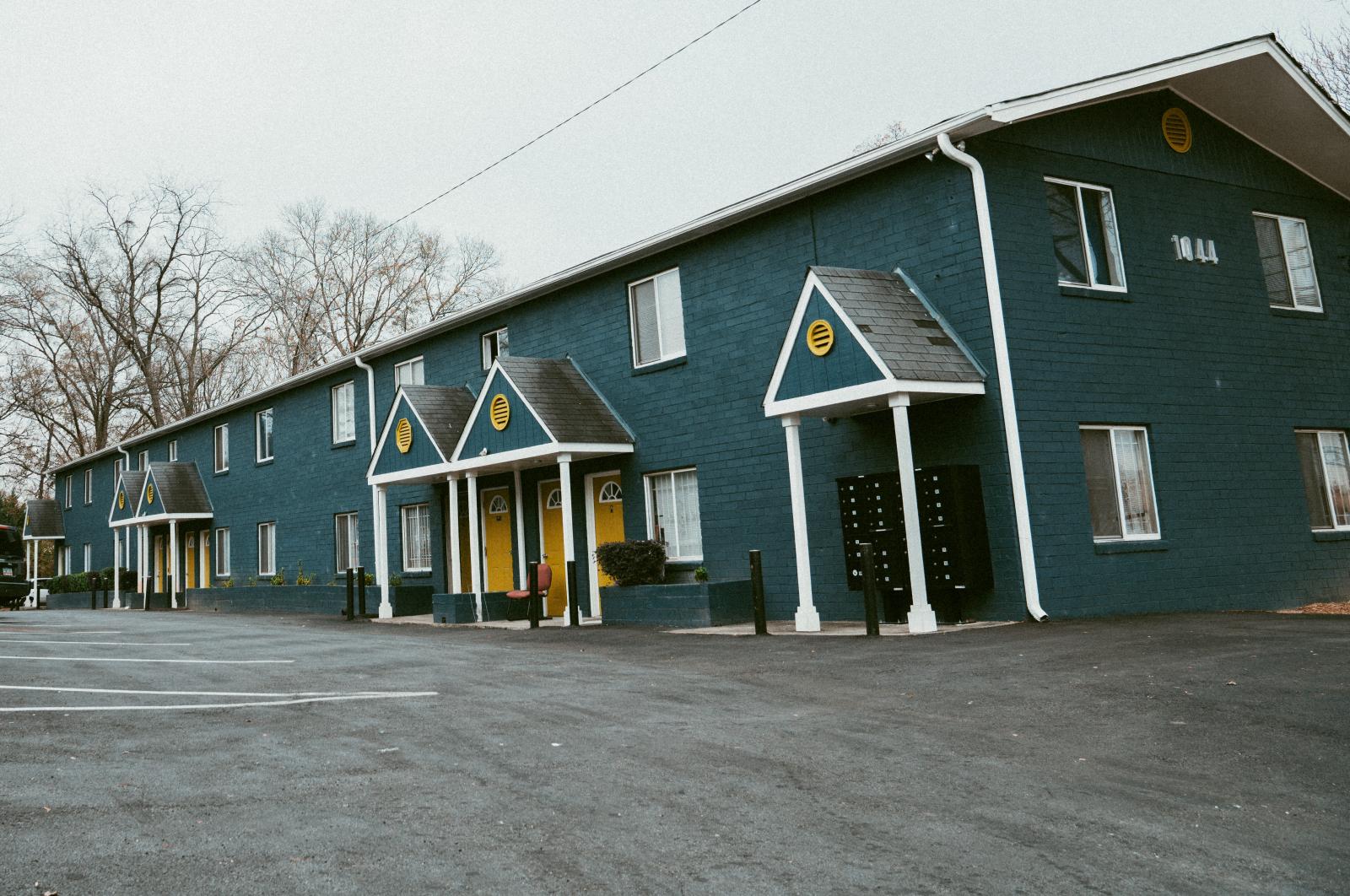
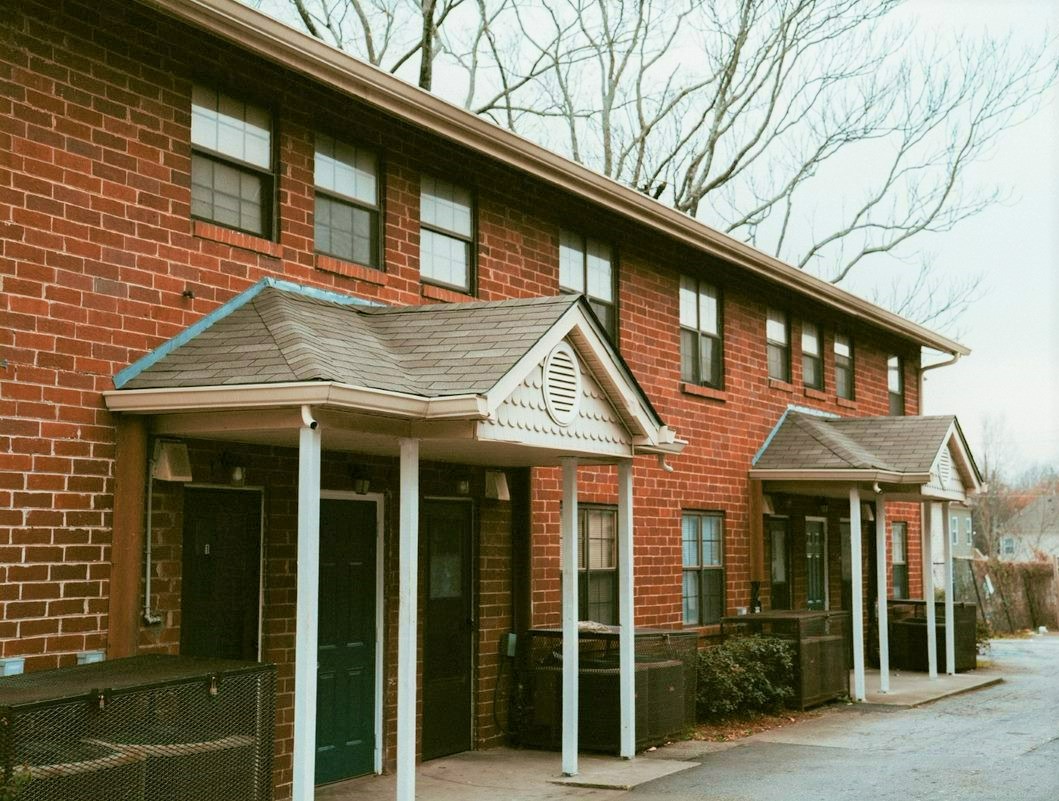
While historically coined as affordable, Metro Atlanta has experienced significant increases in housing costs, both in the rental and homeownership sectors, as the area sees investments such as the Atlanta BeltLine, corporate relocations like Microsoft, and an influx of residents from higher priced markets like New York and California. Since 2020, the Atlanta Metro has experienced a 22% increase in rent costs, while at the same time, the region is experiencing an overall loss of affordable units. Metro Atlanta lost 59,300 units that were rented for $1,250 or less between 2014 and 2019.
Also impacting the Atlanta market is an influx of investors, who are seeking returns through value-add acquisitions, which offer some level of physical improvements paired with rent increases and thus displacement of current residents. A recent study found that investor ownership is directly tied to increases in evictions, and displacement of black families from communities. As we see rising costs, and increased competition, finding solutions to catalyze preservation of affordability is more critical than ever. Finding solutions to catalyze preservation of affordability is more critical than ever.
Housing Affordability and Small to Medium Multifamily Preservation Challenges in Chicago
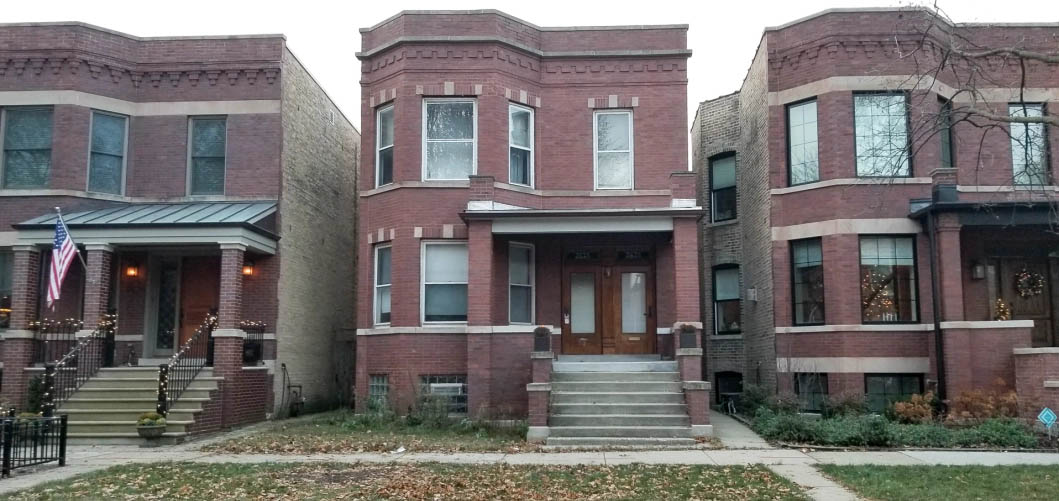
In the City of Chicago, small to medium multifamily (SMMF) buildings with 2 to 4 and 5-49 units can be found in all neighborhoods across the city. These building types, particularly those between 2 to 4 units and older courtyard apartment buildings, were built in the early 20th century and are an integral source of affordable rental housing providing more affordable rents, a greater share of family sized units, and an outsized shared of affordable rentals in Chicago’s communities of color.
Despite their importance, affordable rentals found in Chicago’s ubiquitous two-to-four flat have been declining in recent years, resulting in permanent losses to Chicago’s affordable rental supply. These rental buildings face deterioration and disinvestment in neighborhoods that were hit hard by the 2008 foreclosure crisis and rising rents, and conversions to owner-occupied housing in rising and high-cost markets. In particular, a small number of neighborhoods on the City’s north and northwest side account for the majority of 2 to 4 unit properties that were converted to single-family homes, driven by increased demand from higher-income households. On the other hand, many of these properties were demolished or sit vacant in neighborhoods on Chicago’s South and West sides. While these properties were more likely to be associated with a foreclosure filing, there are few traditional financing products to preserve this critical source of unsubsidized affordable housing.
Housing Affordability and Small to Medium Multifamily Preservation Challenges in Southern California

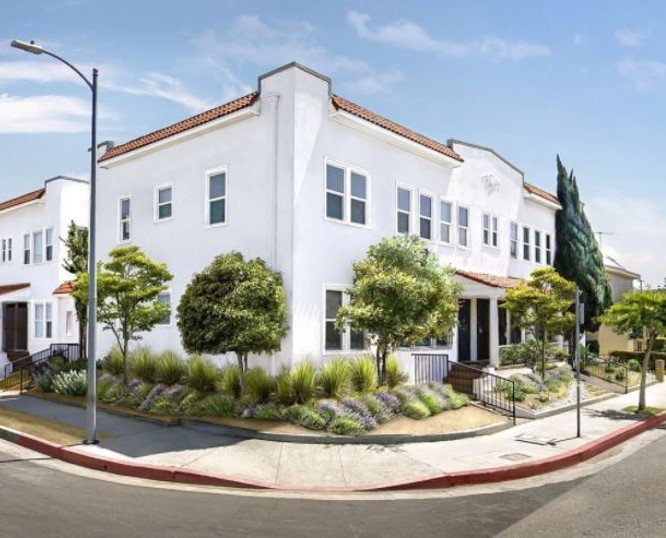
In Los Angeles County, affordable housing remains out of reach for many low-income families as housing costs outpace wages. From 2013 to 2017, median household incomes grew by 2.4 percent while median rents rose by 9.7 percent, and this trend continued during the COVD-19 pandemic as many households faced unemployment and rent arrears. As of 2022, Los Angeles residents must earn three times the state’s minimum wage, $45 an hour, to afford the typical asking rent. Additionally, the region has seen a 71 percent growth in individuals experiencing homelessness, from approximately 38,700 unhoused residents in 2010 to 66,436 in 2020.
Los Angeles county faces a shortfall of roughly 499,430 homes affordable for the region’s low-income households earning below 50% of area median income (AMI). While the City of Los Angeles has added more housing units relative to its population growth compared to any other city in California, roughly 9 percent of these units were affordable to households below the region’s area median income. Additionally, Counties in Southern California have the largest share and number of subsidized homes at risk of losing affordability in the next 10 years, while Los Angeles County is home to nearly 397,000 lower-rent homes in properties without any affordability restrictions.
To stem the region’s housing affordability crisis while advancing its short and long-term housing goals, the region must make significant progress building new and preserving existing affordable housing, particularly for unhoused residents and households on the brink of eviction and displacement.
Housing Affordability and Small to Medium Multifamily Preservation Challenges in New Orleans
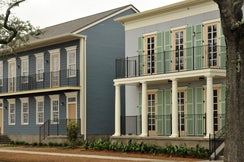
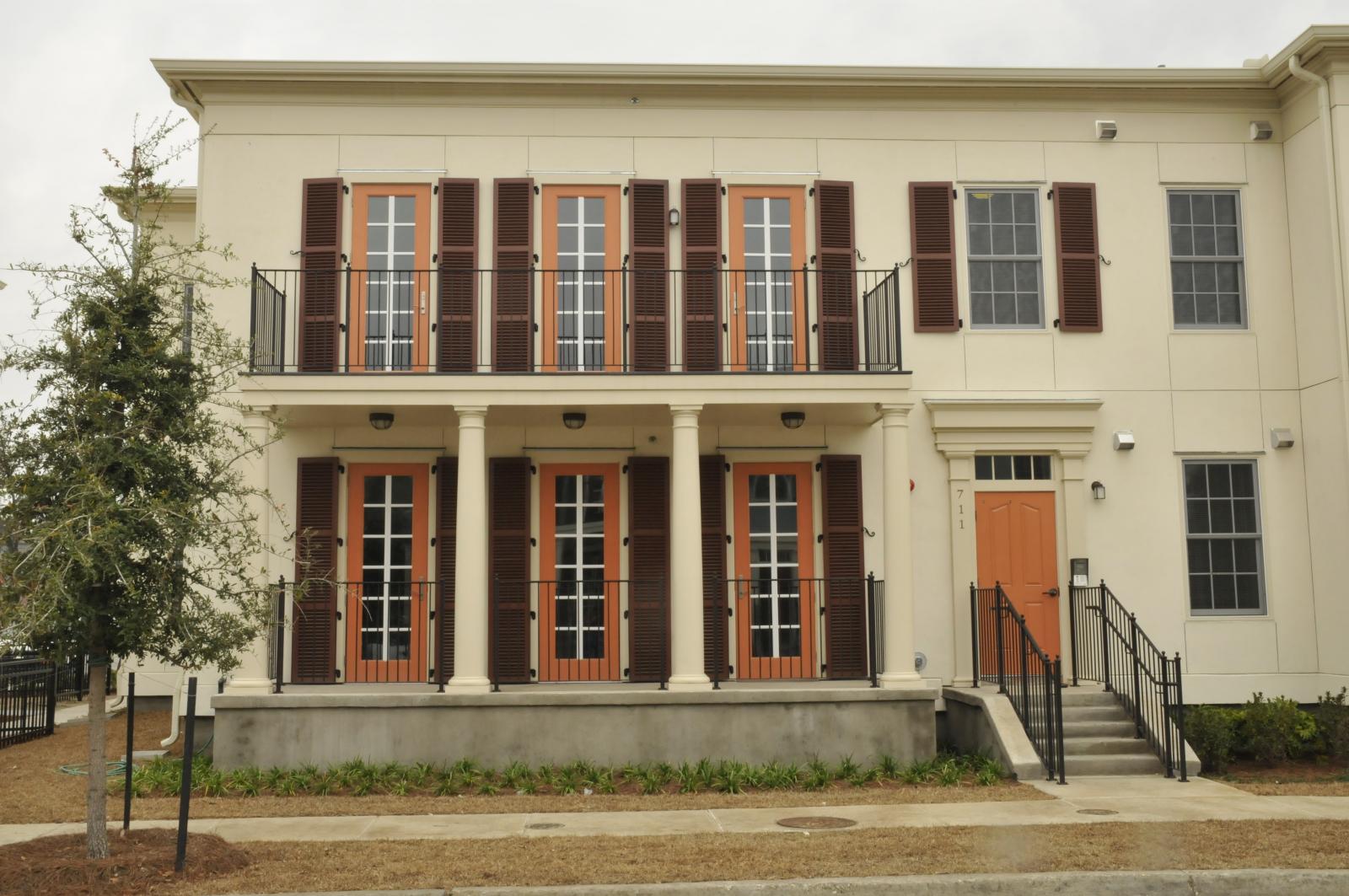
The City of New Orleans’ housing challenges in the last two decades have been characterized by climate change, rising housing costs, and resident displacement. Similar to many cities across the country, New Orleans residents have seen affordable housing grow increasingly out of reach. Data shows that since 2000, inflation-adjusted rents have risen by 49 percent while average incomes have fallen by 8 percent. As a result, the share of renter households that were housing cost burdened grew from 24 to 37 percent from 2004 and 2018 in New Orleans.
Hurricane Katrina and additional storms have also shaped housing opportunity and neighborhood change in New Orleans. During the aftermath of Katrina, a lack of adequate aid left New Orleans’ Black residents unable to repair their homes, and some sold their homes to investors who flipped these homes in historically affordable communities. This led to declines in the affordable housing supply and displacement of Black residents. While Black or African American residents represent the majority of New Orleans residents at 59 percent, that share has fallen from 67 percent in 2000. Meanwhile, communities of color located in higher elevation communities are experiencing gentrification pressures, impacted by a growth in short term rentals.
As New Orleans continues to advance its affordable housing goals, affordable housing advocates and community stakeholders have identified eliminating housing cost burdens, closing the racial health gap, strengthening the resiliency of its housing stock, and combatting displacement as key priorities.
Housing Affordability and Small to Medium Multifamily Preservation Challenges in Colorado
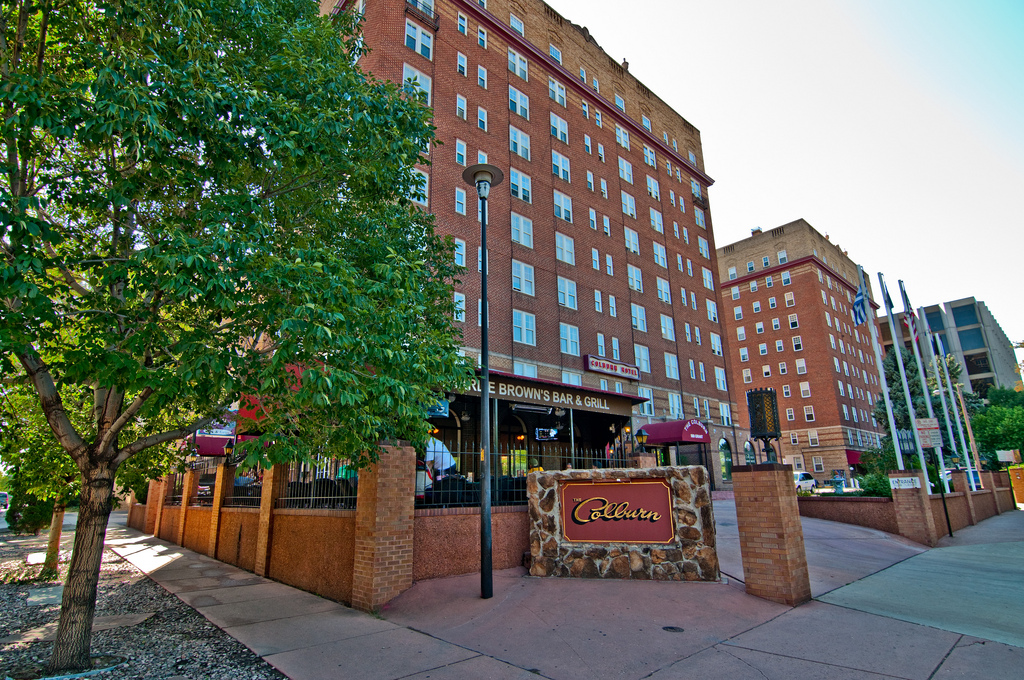
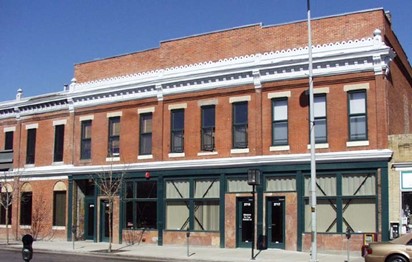
As Denver has become a hotspot for transplants, wages have lagged as the cost of living and rents have significantly grown. In the last decade, Denver experienced a significant influx of roughly 100,000 new residents, resulting in increased rental demand and increased pressure on Denver’s limited supply of affordable rental housing. Many of these affordable rentals are in the region’s aging unrestricted housing stock and lacks protections from rising rents and redevelopment – exacerbating housing affordability challenges as affordable rentals fall out of supply.
Many communities traditionally considered affordable are now facing significant gentrification pressures due to new infrastructure and transit improvements. These dynamics have disproportionately impacted Denver’s lower- and moderate-income renters and BIPOC residents. In 2019, 56 percent of BIPOC renters in Denver were burdened by housing costs compared to 46 percent of all renters. While increased investment can be positive for Denver’s historically low-income neighborhoods of color, it is critical that legacy residents can remain in their community to benefit from improvements.
Statewide, short-term rentals, second homes, and investment properties are becoming a growing share of the housing stock in Colorado’s mountain communities, where homes for current renters and prospective buyers are taken offline. As a result, Colorado ranks the third least affordable state in the nation when median income is compared to median house prices, and roughly half of Colorado renters are housing cost burdened.
Housing Affordability and Small to Medium Multifamily Preservation Challenges in the Bay Area


Across California, homes affordable to low-income households that lack affordability restrictions comprise of nearly 70 percent of the affordable housing supply. These homes can be found in smaller sized fourplexes in predominately residential neighborhoods, moderately sized 10-to-20-unit hotel/motel style apartment buildings, and higher-density single-room occupancy buildings.
Preserving unsubsidized affordable homes in these small to medium multifamily (SMMF) properties is a critical affordable housing strategy to meet the Bay Area’s housing affordability challenges, particularly as the region has some of the highest construction costs, rents, and home prices in the country. However, these SMMF properties are being lost to housing market pressures and redevelopment. Between 2017 and 2019, the Bay Area lost roughly 32,000 rental homes in affordable multifamily properties.
These buildings are also disproportionately located in the Bay Area’s low-income communities and communities of color and are affordable due to their location, ownership structure, and age. However, these communities are also the most at-risk of gentrification and resident displacement due to high levels of renter cost burden and growing investor interest in buying this housing stock. Since many of these properties are older, they are likely subject to rent stabilization laws in a handful of California jurisdictions. In these instances, affordable units in SMMF properties are subject to annual rent increases that shield low-income tenants from instability and displacement.
Housing Affordability and Small to Medium Multifamily Preservation Challenges in the Washington, D.C. Region


As a high-cost region, housing affordability challenges are widespread: a high share of renters experience cost-burdens; rent increases outpace household earnings and often rank as some of the highest in the nation; and these challenges fall hardest on families with the lowest income and Black and Hispanic/Latino renters. With limited land available in the Washington, D.C. region and surrounding jurisdictions to build new homes, many regional leaders recognize the need to preserve and improve unsubsidized multifamily buildings as part of the strategy to increase the region’s committed affordable housing supply and enhance residents’ stability and well-being.
While it is difficult to generalize the complex preservation issues across a large and diverse region like metropolitan Washington, they tend to fall into two main categories. Unrestricted properties in growing areas experiencing development pressure or near existing or planned transit service by Metro and MTA’s Purple Line garner interest among investors and developers who see these properties as profitable investments. In other parts of the region, where public and private disinvestment has contributed to racial and economic disparities, these properties need significant improvements, often to correct long-term deferred maintenance and neglect, and often need to be modernized to serve the existing tenants, such as aging seniors in need of accessibility modifications or families in need of more bedrooms.
[i] Elora Lee Raymond, Ben Miller, Michaela McKinney & Jonathan Braun (2021) Gentrifying Atlanta: Investor Purchases of Rental Housing, Evictions, and the Displacement of Black Residents, Housing Policy Debate, 31:3-5, 818-834, DOI: 10.1080/10511482.2021.1887318
The Small to Medium Multifamily Rental Housing Stock
The Small to Medium Multifamily Rental Housing Stock in Atlanta
The Small to Medium Multifamily Rental Housing Stock in Chicago
The Small to Medium Multifamily Rental Housing Stock in Southern California
The Small to Medium Multifamily Rental Housing Stock in New Orleans
The Small to Medium Multifamily Rental Housing Stock in Colorado
The Small to Medium Multifamily Rental Housing Stock in the Bay Area
The Small to Medium Multifamily Rental Housing Stock in the Washington, D.C. Region
Size
There are an estimated 315,100 rental units in small to medium multifamily (SMMF) properties in Atlanta, which represents half (50.3 percent) of the total rental housing stock. Of SMMF properties, the largest share of these units is in buildings with 10 to 19 units (36.4 percent of all SMMF rental units), followed by buildings with 5 to 9 units (27.6 percent).
Figure 1
Distribution of SMMF Units by Building Size
Atlanta (2020)
There are an estimated 800,041 rental units in SMMF properties in the Chicago region, which represents 60 percent of the total rental housing stock. The largest share of these units is in buildings with 2 to 4 units (43 percent of all SMMF rental units), followed by buildings with 5 to 9 units (28 percent).
Figure 1
Distribution of SMMF Units by Building Size
Chicago (2020)
There are an estimated 1,262,727 rental units in small to medium multifamily (SMMF) properties in Southern California, which represents 53 percent of the total rental housing stock. The largest share of these units is in buildings with 20 to 49 units (26 percent of all SMMF rental units), followed by buildings with 5 to 9 units (24 percent).
Figure 1
Distribution of SMMF Units by Building Size
Southern California (2020)
There are an estimated 102,214 rental units in small to medium multifamily (SMMF) properties in the New Orleans region, which represents 53 percent of the total rental housing stock. The largest share of these units is found in 2-to-4-unit buildings: Buildings with 2 units comprise of 28 percent of all SMMF rental units and buildings with 3 and 4 units total 25 percent.
Figure 1
Distribution of SMMF Units by Building Size
New Orleans (2020)
There are an estimated 367,834 rental units in small to medium multifamily (SMMF) properties in the State of Colorado, which represents 48 percent of the total rental housing stock. The largest share of these units is in buildings with 10 to 19 units (28 percent of all SMMF rental units), followed by buildings with 20 to 49 units (27 percent).
Figure 1
Distribution of SMMF Units by Building Size
Colorado State (2020)
There are an estimated 614,200 rental units in SMMF properties in the San Francisco metropolitan region, which represent 49 percent of the total rental housing stock. Each segment of the SMMF rental stock over two-units – buildings with 3 to 4 units, 5 to 9 units, 10 to 19 units, and 20 to 49 units – represent a proportionate share of the overall stock, roughly 22 percent for each building size type.
Figure 1: Distribution of SMMF Units by Building Size, San Francisco Bay Area (2020)
There are an estimated 384,291 rental units in SMMF properties in the Washington, DC metropolitan area, which represents 44 percent of the total rental housing stock. The largest share of these units is in buildings with 10 to 19 units (46 percent of all SMMF rental units), followed by buildings with 5 to 9 buildings (25 percent).
Figure 1: Distribution of SMMF Units by Building Size, Washington, D.C. Region (2020)
Affordability
In the Atlanta region, homes located in SMMF properties are especially important to lower-income households, providing a bulk of homes for the region’s workforce. Of homes affordable to households at or below 80% AMI in the region, 70 percent are found in SMMF properties.
SMMF homes are more likely to provide affordable housing for lower-income households in Atlanta than the rental housing stock as a whole. Across all SMMF properties in the Atlanta region, 72 percent of units are affordable to households at or below 80 percent AMI. This is 5 percentage points higher than the share of all rental units in the Atlanta region that are affordable to these households. Units affordable to the lower income renters – those at 60 percent of median renter income are similarly distributed among SMMF properties and in all rental properties in Atlanta. Nearly all, 99 percent, of these affordable SMMF units are unsubsidized and have no affordability restrictions.
Figure 2
Affordability of SMMF Units by Local Area Median Household Income Levels
Atlanta (2020)
SMMF homes are more likely to provide affordable housing for lower-income households in Atlanta than the rental housing stock as a whole.
In Chicago, homes located in SMMF properties are especially important to households earning 80 percent area median income (AMI) or less, providing a majority of affordable homes for the region’s lower-income households. Of all homes affordable to lower-income households in Chicago, 74 percent are found in SMMF properties.
SMMF homes are more likely to provide affordable housing for lower-income households in Chicago than the rental housing stock as a whole. Across all SMMF properties in the region, 83 percent of units are affordable to households at or below 80 percent AMI. This is 7 percentage points higher than the share of all rental units in the region. Nearly all, 98 percent, of these affordable SMMF units are unsubsidized and have no affordability restrictions.
Figure 2
Affordability of SMMF Units by Local Area Median Household Income Levels
Chicago (2020)
SMMF homes are more likely to provide affordable housing for lower-income households in Chicago than the rental housing stock as a whole.
In Southern California, homes located in SMMF properties are especially important to households earning 80 percent AMI or less, providing a majority of affordable homes for the region’s lower-income households. Of all homes affordable to lower-income households across the state, 75 percent are found in SMMF properties.
SMMF homes are more likely to provide affordable housing for lower-income households in Southern California than the rental housing stock as a whole. Across all SMMF properties in Southern California, two thirds – 67 percent – of units are affordable to households at or below 80 percent AMI. This is 5 percentage points higher than the share of all rental units in the region. Units affordable to low-income renters (those at or below 60 percent of median renter income) are similarly distributed among SMMF properties and in all rental properties in Southern California. Nearly all, 97 percent, of these affordable SMMF units are unsubsidized and have no affordability restrictions.
Figure 2
Affordability of SMMF Units by Local Area Median Household Income Levels
Southern California (2020)
SMMF homes are more likely to provide affordable housing for lower-income households in Southern California than the rental housing stock as a whole.
In New Orleans, homes located in SMMF properties are especially important to households earning 80 percent area median income (AMI) or less, providing a majority of affordable homes for the region’s lower-income households. Of all homes affordable to lower-income households in New Orleans, 65 percent are found in SMMF properties.
SMMF homes are more likely to provide affordable housing for lower-income households in New Orleans than the rental housing stock as a whole. Across all SMMF properties in the region, 76 percent of units are affordable to households at or below 80 percent AMI. This is 3 percentage points higher than the share of all rental units in the region. Nearly all, 96 percent, of these affordable SMMF units are unsubsidized and have no affordability restrictions.
Figure 2
Affordability of SMMF Units by Local Area Median Household Income Levels
New Orleans (2020)
In Colorado, homes located in SMMF properties are especially important to households earning 80 percent area median income (AMI) or less, providing more than half of affordable homes for the region’s lower-income households. Of homes affordable to lower-income households across the state, 66 percent are found in SMMF properties.
SMMF homes are more likely to provide affordable housing for lower-income households in Colorado than the rental housing stock as a whole. Across all SMMF properties in Colorado, 74 percent of units are affordable to households at or below 80 percent AMI. This is 7 percentage points higher than the share of all rental units statewide. Units affordable to low-income renters (those at or below 60 percent of median renter income) are similarly distributed among SMMF properties and in all rental properties in Colorado. Nearly all, 95 percent, of these affordable SMMF units are unsubsidized and have no affordability restrictions.
Figure 2: Affordability of SMMF Units by Local Area Median Household Income Levels, Colorado state (2020)
In the San Francisco Bay Area, homes located in SMMF properties are especially important to households earning 80 percent area median income (AMI) or less, providing a bulk of homes for the region’s lower-income households. Of homes affordable to lower-income households at or below 80 percent AMI in the region, 77 percent are found in SMMF properties.
Across all SMMF properties in the Bay Area, 60 percent of units are affordable to households at or below 80 percent AMI. Approximately 35 percent of units are affordable to households 0-60 percent AMI and 34 percent are affordable to households 61-80 percent AMI. Nearly all, 97 percent, of these affordable SMMF units are unsubsidized and have no affordability restrictions.
Figure 2: Affordability of SMMF Units by Local Area Median Household Income Levels, San Francisco Bay Area (2020)
In the Washington, DC region, homes located in SMMF properties are especially important to households earning 80 percent area median income (AMI) or less, providing a bulk of homes for the region’s lower-income households. Of homes affordable to lower-income households at or below 80 percent AMI in the region, 81 percent are found in SMMF properties.
SMMF homes are more likely to provide affordable housing for lower-income households in the Washington DC region than the rental housing stock as a whole. Across all SMMF properties in the Washington, DC region, 68 percent of units are affordable to households at or below 80 percent AMI. This is 15 percentage points higher than the share of all rental units in the DC region. Units affordable to the low-income renters – those at 60 percent of median renter income, show a similar trend. More than half, 55 percent, of units in SMMF properties are affordable to this income segment, compared to 43 percent in all rental properties. Nearly all, 97 percent, of these affordable SMMF units are unsubsidized and have no affordability restrictions.
Figure 2: Affordability of SMMF Units by Local Area Median Household Income Levels, Washington, D.C. Region (2020)
The Preservation Landscape
The Atlanta Preservation Landscape
The Preservation Landscape in Chicago
The Southern California Preservation Landscape
The Preservation Landscape in New Orleans
The Colorado Preservation Landscape
The Bay Area Preservation Landscape
The Preservation Landscape in the Washington, D.C. Region
Preservation Stakeholders
- Public Sector
-
Advocate or Coalition
-
Non-profit Owners
-
-
Property Owners
-
For Profit Owners
-
Investors
-
Public Entities and Housing Authorities
-
Independent Owners
-
-
Financial Partners
-
Banks
-
Government Sponsored Entities (GSEs)
-
Philanthropy
-
-
Brokers
SMMF Preservation and eviction prevention efforts across the Atlanta region are guided by public agencies, financial institutions, nonprofit and for-profit developers, and housing advocates.
Enterprise’s Southeast market works to advance the preservation of unsubsidized affordable homes and promote housing stability by offering developers and housing providers the tools and training, technical assistance and grants, and capital resources to acquire, rehabilitate, and preserve the affordability of SMMF properties.
Public partners, such as Invest Atlanta, provide funding resources towards the preservation of this smaller stock, including the Housing Opportunity Bond.
HouseATL convenes three working committees focused on funding, policy and housing stability and works to incorporate a preservation priority within each committee’s efforts.
-
Public Sector
-
Housing Finance Authority
-
Public Entities and Housing Authorities
-
Property Owners
-
Non-profit Owners
-
For Profit Owners
-
-
Financial Partners
-
Community Development Financial Institutions (CDFIs)
-
Banks
-
Philanthropy
-
Funder
-
-
Consultant or Service Provider
-
Energy Efficiency
-
Data and Research
-
- Advocate or Coalition
- Brokers
Enterprise’s Chicago market is a convenor of the Chicago Flats Initiative, a coalition of community organizations to help residents remain stably housed in the city’s 2-to-4-unit buildings and mitigate the loss of these properties to foreclosure or market pressures during the COVID-19 pandemic.
The City of Chicago Department of Housing sets affordable housing preservation priorities and implements key programs and policies that preserve the affordable SMMF rental stock in Chicago, including the Woodlawn Preservation Ordinance, 606-Pilsen Demolition Permit Surcharge, and the Multifamily TIF Purchase-Rehab Program. Read more about these policies below.
Non-profit affordable housing development organizations. Organizations such as Preservation of Affordable Housing (POAH), Chicago Metropolitan Housing Development Corporation (CMHDC), The Resurrection Project, and LUCHA have acquired, rehabilitated, and are operating affordable SMMF properties in Chicago.
Preservation advocates such as the Preservation Compact, the Institute for Housing Studies at DePaul University, and Metropolitan Planning Commission are important organizations in the preservation ecosystem that makes the case to help advance policy, disseminates research and data, and convenes organizations for preservation initiatives, such as the Preservation Lab and neighborhood planning initiatives such as Preservation Affordability Together.
Funders and CDFIs are key preservation actors that provide critically important capital resources for preservation. These include CDFIs Community Investment Corporation, Chicago Community Loan Fund, and Neighborhood Lending services, organizations that have collaborated to put SMMF properties back into the affordable housing inventory after the foreclosure crisis.
Community-based organizations. Chicago is home to a vast network of community-based organizations that have been key partners in the design, implementation, and passage of preservation programs. Efforts from organizations, including Communities United and the Obama Community Benefits Agreement Coalition, have led to city-adopted preservation programs and policies, namely thePreservation of Existing Affordable Rental (PEAR) program and Woodlawn Preservation Ordinance.
Independent SMMF owners and operators. Helping owners and operators of affordable homes to maintain stable operations is a key pathway of preservation work in Chicago. The Preservation Compact supports this stakeholder group by providing training and tools to these owners, such as resources on property management, energy efficiency and other renovations, and property tax abatements.
-
Public Sector
-
Housing Finance Authority
-
Public Entities and Housing Authorities
-
-
Property Owners
-
Independent Owners
-
Non-profit Owners
-
Community land trusts
-
-
Financial Partners
-
Community Development Financial Institutions (CDFIs)
-
- Advocate or Coalition
Enterprise’s Southern California market works to advance the preservation of affordable homes that are connected to services for the region’s most vulnerable populations, stabilize the small to medium multifamily rental housing stock by supporting Black, Indigenous and people of color (BIPOC) rental property owners, and provide capital solutions through flexible acquisition, predevelopment and moderate rehabilitation for affordable housing developers.
Non-profit affordable housing development organizations. Affordable housing and community development organizations acquiring, rehabilitating, and preserving affordability in SMMF properties in Southern California include East Los Angeles Community Corporation, Coalition for Responsible Community Development, Venice Community Development Corporation, and Little Tokyo Service Corporation. These efforts are supported by community land trusts, which include T.R.U.S.T. South LA, Fideicomiso Comunitario Tierra Libre, Beverly Vermont Community Land Trust, and El Sereno Community Land Trust.
Local jurisdictions, public agencies, and funders across Southern California set preservation and resident stability priorities, create and administer preservation programs, and allocate and provide public resources for preservation capital and capacity building.
Independent landlords own 76 percent of all unsubsidized, below market housing units in Los Angeles County. Providing resources and stabilizing this stakeholder group can help stem the loss of unrestricted units in SMMF properties.
-
Public Sector
-
Public Entities and Housing Authorities
-
Housing Finance Authority
-
-
Property Owners
-
Community land trusts
-
Non-profit Owners
-
-
Financial Partners
-
Housing Finance Authority
-
Banks
-
- Advocate or Coalition
-
Consultant or Service Provider
-
Data and Research
-
Enterprise’s Gulf Coast market supports an inclusive infrastructure and production system for affordable homes through new capital, housing policies and resources to developers and organizations. The market also promotes policies and programs that support stable housing, reduce displacement and evictions and close the racial wealth gap.
Local jurisdictions, public agencies, and funders across New Orleans set affordable housing preservation and production goals and allocate public resources for preservation activities. These include the State of Louisiana Office of Community Development, which distributes disaster recovery aid throughout the state, the New Orleans Redevelopment Agency and Louisiana Housing Corporation, which provides capital resources for affordable housing development.
Non-profit affordable housing development organizations and advocates. Organizations such as Home by Hand are acquiring, rehabilitating, and preserving affordability in SMMF properties in New Orleans. Community land trusts such as Jane Place Neighborhood Sustainability Initiative and organizations such as Housing NOLA, Housing Louisiana, and Louisiana Fair Housing Action Center are advocating for initiatives that that prevent resident displacement and promote fair housing access.
-
Public Sector
-
Housing Finance Authority
-
Local Municipalities
- Colorado Department of Local Affairs
-
-
Property Owners
-
Mom and Pop Owners
-
Non-profit Owners
-
For Profit Owners
-
Investors
-
Public Entities and Housing Authorities
-
-
Financial Partners
-
Banks
-
PHILANTHROPY
-
PUBLIC ENTITIES AND HOUSING AUTHORITIES
-
Community Development Financial Institutions (CDFIs)
-
Government Sponsored Entities (GSEs)
-
-
Community
-
EMPLOYERS
-
COMMUNITY ORGANIZERS
-
EDUCATORS
-
RESIDENTS OF DEED RESTRICTED HOMES
-
HEALTHCARE PROVIDERS
-
Residents of affordable homes without deed restrictions
-
Preservation and eviction prevention efforts across the Denver region are guided by public agencies, financial institutions, nonprofit and for-profit developers, and housing advocates.
Enterprise’s Rocky Mountain market works to advance the preservation of unsubsidized affordable homes and promote housing stability by offering developers and housing providers the tools and training, technical assistance and grants, and capital resources to acquire, rehabilitate, and preserve the affordability of SMMF properties.
Colorado Housing & Finance Authority (CHFA) provides fast acting acquisition and permanent financing to developers and purchasers to deploy for acquisition and rehabilitation – including their Colorado Affordable Housing Preservation Fund and Multifamily Permanent Loan programs.
The Colorado Division of Housing (CDOH) provides SMMF owners with Colorado Division of Housing Development Grants and Housing Development Loans which can be paired with CHFA capital products for the acquisition and rehabilitation of existing rental properties.
Neighborhood Development Collaborative consists of over 20 non-profit organizations in the Denver metropolitan region that produce and preserve affordable homes for low-to-medium income households.
-
Public Sector
-
Housing Finance Authority
-
Public Entities and Housing Authorities
-
Property Owners
-
Non-profit Owners
-
Community Land Trusts
-
Independent Owners
-
-
Financial Partners
-
Community Development Financial Institutions (CDFIs)
-
Funder
-
- Advocate or Coalition
-
Consultant or Service Provider
-
Finance
-
Preservation and eviction prevention efforts across the Bay Area region are led by public agencies, financial institutions, nonprofit and for-profit developers, and housing advocates. Each stakeholder group and individual organization or entity plays an important and complementary role in the Bay Area’s preservation ecosystem, working together to build and increase capacity, improve the implementation and advocate for the adoption of new policies and programs, and create and shape financial resources to increase the region’s preservation pipeline.
Enterprise’s Northern California market works to advance the preservation of unsubsidized affordable homes and promote housing stability by offering developers and housing providers the tools and training, technical assistance and grants, and capital resources to acquire, rehabilitate, and preserve the affordability of SMMF properties. Read more about Enterprise Northern California’s preservation work here
Non-profit affordable housing development organizations. The Bay Area includes a large network of community-based nonprofit organizations acquiring, rehabilitating, and preserving affordability in SMMF properties, including organizations such as the Unity Council, Mission Economic Development Agency, East Bay Asian Local Development Corporation, Chinatown Community Development Corporation, Tenderloin Neighborhood Development Corporation, and a network of community land trusts.
Funders and lenders such as community development finance institutions like the Housing Accelerator Fund, the Bay Area Housing Finance Agency, philanthropic and impact investors such as Partnership for the Bay’s Future and Kaiser Permanante provide the ecosystem of preservation purchasers with below-market and critical funding resources to advance acquisition-rehabilitation efforts.
Preservation advocates and coalitions help ensure tenant-led strategies are reflected in preservation programs, help co-design preservation initiatives, disseminate relevant data and research, and push for greater resources for preservation.
Local jurisdictions and public agencies across the nine-county Bay Area set preservation and resident stability priorities, create and administer preservation programs, and allocate and provide public resources for preservation capital and capacity building.
-
Public Sector
-
-
Local departments of housing and community development
-
Local housing authorities
-
-
Property Owners
-
Non-profit Owners
-
NON-PROFIT OWNERS
-
-
Financial Partners
-
Community Development Financial Institutions (CDFIs)
-
Philanthropy
- Kaiser Permanente
- JP Morgan Chase
- Washington Regional Association of Grantmakers
-
Investors
-
Banks
-
-
Advocate or Coalition
Preservation and eviction prevention efforts across the Washington, D.C. region are often guided by coalitions comprised of public agencies, financial institutions, nonprofit and for-profit developers, and housing advocates, such as DC’s Preservation Network, and result in shared information and data like the Northern Virginia Affordable Housing Alliance’s Eviction Prevention Dashboard and DC Preservation Network’s Housing Insights Tool. These groups continue to find ways to improve existing tools, increase preservation resources, and explore new ones, like land use tools to incentivize preservation of MARKS – the county’s term for unsubsidized affordable units – as part of Arlington County’s Multifamily Reinvestment Study.
Preservation Policies, Programs, and Initiatives
In Atlanta, the preservation of unsubsidized affordable SMMF fits into a broader housing framework focused on increasing housing diversity, especially “missing middle” housing types; meeting diverse households’ needs, including workers such as first responders and teachers; and minimizing increased pressure on legacy residents due to increasing housing costs.
The importance of preserving unsubsidized affordable SMMF is well- documented across plans and studies for the City of Atlanta. It also reinforces the broader strategies of One Atlanta: Housing Affordability Action Plan and HouseATL to build capacity, especially among nonprofits, and catalyze innovation and new ideas for affordable housing development.
The Preservation Lab, a coalition of stakeholders convened by The Preservation Compact and the Institute for Housing Studies at DePaul University, combines applied research with engagement of affordable housing practitioners in Chicago. Their work examined strategies to keep renters stably housed and stabilize affordable properties during the COVID-19 pandemic and an analysis of challenges and solutions for the unsubsidized SMMF rental stock in Chicago.
A suite of preservation policies recently passed by the Chicago Department of Housing complement existing programs that work to stem the loss of unsubsidized affordable housing properties in communities across the city. These include zoning changes that restrict the demolition and conversion of SMMF properties along the city’s Bloomingdale Trail and a new set of funding sources to preserve affordable rental housing, promote BIPOC homeownership, and guide equitable investment near the catalytic Obama Presidential Library.
The Chicago Flats Initiative is a coalition of community organizations to help residents remain stably housed in the city’s 2-to-4-unit buildings and mitigate the loss of these properties to foreclosure or market pressures during the COVID-19 pandemic.
The Los Angeles Rental Owners Collaborative (LROC) supports independent BIPOC rental property owners of 2-20 unit buildings in South Los Angeles. The program helped these owners, a critical component of the affordable SMMF ecosystem in Los Angeles, navigate the economic instability caused by the COVID-19 pandemic and build a strong network of support services, including financial consulting and property management tools.
Catalyzed through Los Angeles County’s Pilot Community Land Trust Partnership Program, a network of community development corporations and community land trusts are partnering together to preserve unsubsidized affordable homes at risk of market conversion, ensure permanent affordability through community ownership models, and advocate for local policy and capital solutions for SMMF preservation.
The Los Angeles Housing Department administers the Affordable Housing Preservation Program, implementing strategies to extend the affordability of subsidized housing at-risk of losing affordability restrictions. The Department is also developing new preservation programs aimed at the unrestricted affordable housing stock, including the Naturally Occurring Affordable Housing (NOAH) Program and the USC Preservation Loan Program.
Amending the zoning ordinance to allow for SMMF properties. While much of New Orleans’ housing stock can be found in three and four-unit buildings, many of these properties are nonconforming uses due to recently enacted downzoning. In 2021, The City of New Orleans passed a zoning amendment that allows triplexes and fourplexes by right if one unit is set aside for lower-income households at or below 80% of area median income.
Restrictions on short-term rentals. The City of New Orleans passed two ordinances to place restrictions on the city’s short-term rentals, which were taking affordable homes out of the supply and putting upward pressure on housing costs in historically affordable communities.
Right to Counsel. The New Orleans set aside $2 million in funding to support a right to counsel and eviction court program, providing free legal representation to tenants – a critical step to help low-income residents in a city with an eviction rate that is twice the national average.
Since 2016, the Colorado Housing Preservation Network, a partnership between the Colorado Housing Finance Authority (CHFA), Enterprise Community Partners, the State Division of Housing, City of Denver Office of Housing Stability, and the Neighborhood Development Collaborative have worked together to create data-driven preservation solutions, find ways to improve existing preservation tools, and develop preservation financing products. Initially formed to address the nearly 14,000 affordable units with expiring restrictions, HPN has expanded their work to include strategies to preserve unrestricted and unsubsidized units.
To date, the Colorado Housing Preservation Network’s work includes:
Analysis of Multi-Family Housing Inventory in the Metro Denver Area. The Colorado Futures Center, Enterprise, and Mile High Connects developed a detailed parcel-level analysis of the ownership characteristics of SMMF properties in the seven-county metro Denver area. This data is used to inform acquisition opportunities, technical assistance strategies, and property owner engagement.
Development of Preservation Finance Tools. CHFA, Enterprise, Neighborhood Development Collaborative, HOST and the Colorado Division of Housing identified key financing gaps and challenges in Colorado. CHFA launched the Colorado Affordable Housing Preservation (CAHP) Program: A low-cost rapid acquisition fund for purchasers of affordable properties.
Owner and Purchaser Training, Tools, and Technical Assistance. In addition to flexible capital resources and data, The HPN identified the need for training and technical assistance to understand the need and changes of current and future owners of SMMF properties to build relationships and effectively deploy resources. Enterprise and CHFA hosted a Small Landlord Training series in 2022 and Enterprise will be hosting the Preservation Next Academy in 2023.
Preservation is a key priority in Housing an Inclusive Denver, a five-year plan that outlines strategies to promote housing affordability and economic mobility. To preserve 1,000 existing affordable housing units by 2023, the plan recommends to:
Create a rental registry to collect comprehensive data and to better understand Denver’s small-scale unsubsidized affordable housing stock (underway)
Explore financing tools to incentivize existing owners to preserve their smaller properties, including resources for rehabilitation and tax relief
Explore development of a finance tool that leverages public and private resources to acquire small-scale unsubsidized properties, taking San Francisco’s Small Sites Acquisition Program as a promising model
Expand financial resources for preservation by creating a dedicated preservation fund or creating new resource through bonds and fees
San Francisco’s Small Sites Program. Administered by the Mayor’s Office of Housing and Community Development, the Small Sites Program launched in 2014 to protect San Francisco residents living in unsubsidized properties at-risk of displacement and Ellis Act evictions and converts them to permanently affordable housing. The program has taken approximately 650 units in San Francisco off the speculative market and serves as a model for preservation programs in high-cost markets.
Bay Area Preservation Pilot (BAPP) is the nine-county Bay Area’s first preservation financing tool seeded by a transportation agency, the Metropolitan Transportation Commission (MTC). BAPP seeks to provide fast moving capital for organizations and developers to purchase, meet immediate rehabilitation needs, stabilize SMMF properties and prevent resident displacement until longer-term financing is identified and secured.
Community and Tenant Opportunity to Purchase (COPA/TOPA). San Francisco’s Community Opportunity to Purchase Act provides a set of qualified non-profit organizations the right of first offer and/or the right of first refusal to purchase specific properties to stem the loss of affordable housing and prevent displacement of residents. Cities across the state, including Oakland and Berkeley, have advocated for their own TOPA/COPA laws.
Increasingly improving multifamily properties and protecting residents and affordability are policy objectives among many jurisdictions in the Washington, D.C. region. As one part of their preservation strategy, these jurisdictions are focused on ways to convert unsubsidized affordable homes into committed affordable homes to guarantee their affordability.
Jurisdictions in the Washington, D.C. region have enacted policies to transfer properties to tenants, public entities, or mission-minded developers. For example, Washington, D.C.’s Tenant Opportunity to Purchase and subordinate District Opportunity to Purchase acts and right of first refusal policies in Montgomery and Prince George’s counties. They have enacted policies to protect and support tenants at these properties, including Washington, D.C.’s just cause eviction law and Arlington County’s Tenant Relocation Guidelines for tenants affected by redevelopment or conversions.
About Preservation Next. Preservation Next is an Enterprise initiative that combines national subject matter expertise and resources, regional network capacity through our Preservation Academies and capital solutions to preserve affordable yet unsubsidized SMMF properties at-risk of rising rents, deterioration, and destabilization. Learn more about Preservation Next here: https://www.enterprisecommunity.org/impact-areas/preservation-and-production/preservation-eviction-prevention
For more information about preservation in this market, including tools such as a funding sources inventory, see the Preservation Next Toolkit: https://preservation-next.enterprisecommunity.org